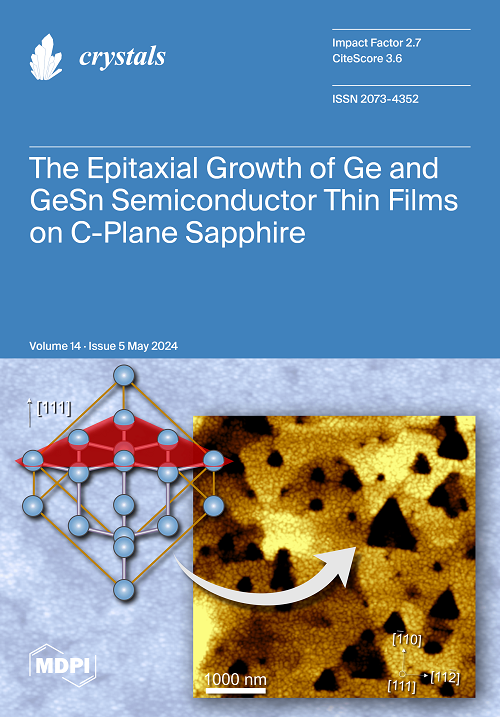Time-Dependent Study of Inclusions in Bearing Steel Subjected to Rare Earth Treatment with Secondary Oxidation
IF 2.4
4区 材料科学
Q2 CRYSTALLOGRAPHY
引用次数: 0
Abstract
Due to the strong reducibility and chemical activity of rare earths, the diffusion behavior and secondary oxidation of rare earths in the steel liquid will also have a significant impact on the modified products when rare earths are added to bearing steel, resulting in poor control of distribution behavior. Therefore, this paper studies the influence of time factors on the evolution of rare earth inclusions. The inclusion evolution behavior at different times when the bearing steel was treated with rare earths and subjected to secondary oxidation was simulated at 1873 K (1600 °C). At a cerium content of 0.012% in steel and a secondary oxidation of 0.0025%, the cerium content in steel and the total oxygen (T.O.) content in steel were determined at the 30 s, 3 min, 5 min, and 7 min after the addition and the inclusions were characterized by automatic scanning electron microscopy. The results demonstrated the formation of a cerium-enriched zone after the addition of the cerium alloy to the steel. As time progressed, a considerable number of inclusions were generated in the cerium-enriched zone, which subsequently disappeared. The trend in the composition of the inclusions can be described as Al2O3 → Ce2O2S + CeS → Ce2O2S. The final composition of the inclusions matches the thermodynamic phase diagram. Following the addition of the transient oxidant Fe2O3 to the molten steel, an oxygen-enriched zone was formed. As time progressed, a considerable number of inclusions were generated in the oxygen-enriched zone and subsequently disappeared. The trend of inclusions composition was as follows: Ce2O3 + CeAlO3 + Al2O3 → Ce2O3 + CeAlO3 → Ce2O2S + CeAlO3. The final inclusion composition coincides with the thermodynamic phase diagram.轴承钢经稀土二次氧化处理后夹杂物的时间依赖性研究
由于稀土具有很强的还原性和化学活性,在轴承钢中添加稀土时,稀土在钢液中的扩散行为和二次氧化也会对改性产品产生很大影响,导致分布行为控制不佳。因此,本文研究了时间因素对稀土夹杂物演变的影响。在 1873 K(1600 °C)下,模拟了轴承钢经稀土处理并进行二次氧化时,不同时间的夹杂物演变行为。在钢中铈含量为 0.012%、二次氧化率为 0.0025%的条件下,分别测定了添加稀土后 30 秒、3 分钟、5 分钟和 7 分钟时钢中的铈含量和总氧 (T.O.) 含量,并通过自动扫描电子显微镜对夹杂物进行了表征。结果表明,钢中加入铈合金后形成了富铈区。随着时间的推移,铈富集区中产生了大量夹杂物,这些夹杂物随后消失。夹杂物成分的变化趋势可描述为 Al2O3 → Ce2O2S + CeS → Ce2O2S。夹杂物的最终成分与热力学相图相符。在钢水中加入瞬时氧化剂 Fe2O3 后,形成了富氧区。随着时间的推移,富氧区产生了大量夹杂物,随后消失。夹杂物成分的变化趋势如下Ce2O3 + CeAlO3 + Al2O3 → Ce2O3 + CeAlO3 → Ce2O2S + CeAlO3。最终的包合物成分与热力学相图相吻合。
本文章由计算机程序翻译,如有差异,请以英文原文为准。
求助全文
约1分钟内获得全文
求助全文
来源期刊

Crystals
CRYSTALLOGRAPHYMATERIALS SCIENCE, MULTIDIS-MATERIALS SCIENCE, MULTIDISCIPLINARY
CiteScore
4.20
自引率
11.10%
发文量
1527
审稿时长
16.12 days
期刊介绍:
Crystals (ISSN 2073-4352) is an open access journal that covers all aspects of crystalline material research. Crystals can act as a reference, and as a publication resource, to the community. It publishes reviews, regular research articles, and short communications. Our aim is to encourage scientists to publish their experimental and theoretical results in as much detail as possible. Therefore, there is no restriction on article length. Full experimental details must be provided to enable the results to be reproduced. Crystals provides a forum for the advancement of our understanding of the nucleation, growth, processing, and characterization of crystalline materials. Their mechanical, chemical, electronic, magnetic, and optical properties, and their diverse applications, are all considered to be of importance.
 求助内容:
求助内容: 应助结果提醒方式:
应助结果提醒方式:


